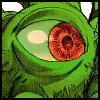Top 15 Cases of Nightmare Fuel in Zelda
Posted on October 25 2013 by Axle D. Wilder
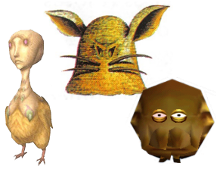 Halloween’s just around the corner, so I thought it was a good time to tackle a certain lovely little article topic: The top examples of “nightmare fuel” in Zelda. While this term can have a broader meaning that applies to anything scary or nightmare-inducing, I’m going with a specific version. In short, I’m covering things that were never meant to be scary, or scary to this degree, but certainly become highly disturbing when you think about them. I suppose you can look at it as fuel for nightmares as opposed to the stuff of nightmares! Creepypasta Wiki describes it best:
Halloween’s just around the corner, so I thought it was a good time to tackle a certain lovely little article topic: The top examples of “nightmare fuel” in Zelda. While this term can have a broader meaning that applies to anything scary or nightmare-inducing, I’m going with a specific version. In short, I’m covering things that were never meant to be scary, or scary to this degree, but certainly become highly disturbing when you think about them. I suppose you can look at it as fuel for nightmares as opposed to the stuff of nightmares! Creepypasta Wiki describes it best:
Not everything on this list was intended to be completely pleasant from the get-go, and in fact a few were supposed to be at least freaky, but in those cases I’m including them for the sake of their added horror factor when examined too closely. So, without further ado, let’s get to my top 15!
15. House of Skulltula (Ocarina of Time)
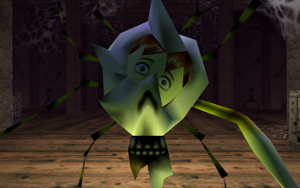 First on this list is a bit of an obvious selection, but appropriate nonetheless: The “Skulltula Family”, for lack of a better name. An old man who also lives Kakariko Village tells the player about a “fabulously rich family that once lived in one of the houses in this village”, who were “cursed due to their greed”. He follows up by musing “Who knows what might happen to those who are consumed by greed…”
First on this list is a bit of an obvious selection, but appropriate nonetheless: The “Skulltula Family”, for lack of a better name. An old man who also lives Kakariko Village tells the player about a “fabulously rich family that once lived in one of the houses in this village”, who were “cursed due to their greed”. He follows up by musing “Who knows what might happen to those who are consumed by greed…”
Why, they’re turned into hideously freakish spiders, you silly old man! Dur!
The Skulltula Family are completely benevolent characters who show no ill-will and function as the reward-givers of the game’s primary sidequest. Collecting tokens from the Gold Skulltulas hidden throughout the world will gradually lift the curse, curing the man’s absurd jumping jack-performing children one at a time, each of which will grant the player a reward, until finally the father is cured and gives the player an infinite supply of rupees.
The origin of the “spider’s curse” is never explained, simply said to be due to their greed, and that each Gold Skulltula must be destroyed to break it. So… is it the Gold Skulltulas themselves who created the curse, or someone else? The transformed family are disturbing enough in appearance alone to be considered frightening, but there are other aspects which add fuel to the nightmare: For one, these are the only non-enemy characters who can be attacked and hurt. Doing so stuns them, as they cry out in agony before retaliating against Link. Second, the old man in Kakariko seems to have no knowledge of the fact that they still live there. Which means that dark web-covered house you find them in is, as far as most people know, abandoned. Which also means these arachnid half-men are lurking in the dark corners of the village, and show themselves only to you, spinning down from the ceiling to greet you.
14. Maggie’s Romance (The Wind Waker)
 A poor girl all her life, Maggie has a lucky break after… erm… being kidnapped by a horde of monsters commanded by an evil wizard; she happens upon a mess of Skull Necklaces, and upon her rescue, her father sells them for massive wealth!
A poor girl all her life, Maggie has a lucky break after… erm… being kidnapped by a horde of monsters commanded by an evil wizard; she happens upon a mess of Skull Necklaces, and upon her rescue, her father sells them for massive wealth!
And what does she do in her happy new life? She remains lovesick over one of her monstrous, piggy captors.
Maggie writes love letters to Moe the Moblin, a member of the porky race, whom she claims was kind to her while she was imprisoned in the Forsaken Fortress and gave her all those Skull Necklaces. Her father, extremely understandably, will not let her send letters to a freaking demon pig monster who held her captive. Of course when Link intervenes, this is the letter that comes back from sweet Moe:
“This is Moe. I… like… you… …Ma…ggie… …so…much…that… …I…want…to… …eat you…for dinner.”
…
Yeah, okay, no, nothing sinister there. Of course little Maggie takes it as a marriage proposal, determining to set out for the Forsaken Fortress at once (although she never does), but I shouldn’t need to explain how she is delusional. This still qualifies as nightmare fuel even if you interpret it as nothing but dopey Moblin speak and that Moe does indeed love her, because in the end no benevolent Moblin is ever spared, meaning in all probability Link killed Moe. This is probably for the best for Maggie, though!
13. Silent Realm (Skyward Sword)
I was reluctant to put this on the list because who am I kidding? The Silent Realm was clearly intended to be scary. From their usually pretty but periodically unsettling music, to the frightening chase theme and the twisted and frightening Guardians that I’ve discussed before, these trials were clearly supposed to be frightening parts of the game.
I’m including it on this list of nightmare fuel because, while it was intended, you certainly wouldn’t think it scary right off the bat. When the music for any of the Silent Realm trials starts, it all seems pretty and benevolent enough; trippy, tinkly spirit world music. Visually, the Silent Realms are beautiful too, even including the Guardians themselves.
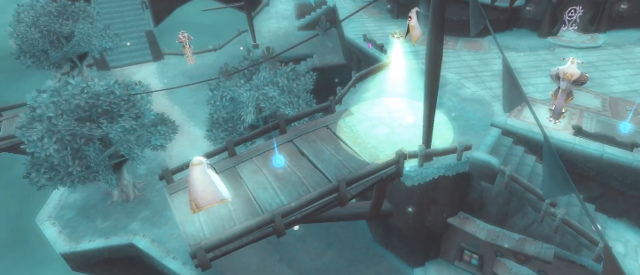
But the biggest point of all is this: Are the Goddesses sociopaths?
These were holy trials designed to test Link’s character and mettle, so why were they so utterly horrifying? I guess we have our answer, since they certainly dwarf any fear-factor Demise might have had, but even then, is that really the best way to build up your hero? To scare him so much that the real evil doesn’t seem so bad anymore? What the hell, Goddesses?
12. Lakebed Temple (Twilight Princess)
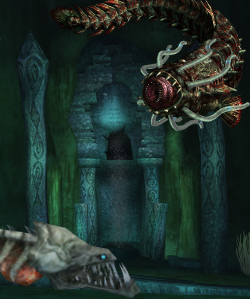 At first glance the Lakebed Temple is just another Water Temple, maybe a little extra pretty for all its coral and whatnot, but still just Twilight Princess’ obligatory water dungeon. Nothing to see here, folks!
At first glance the Lakebed Temple is just another Water Temple, maybe a little extra pretty for all its coral and whatnot, but still just Twilight Princess’ obligatory water dungeon. Nothing to see here, folks!
However, if you closer examine this place, there’s a huge implied secret which is, in my eyes, quite freaky.
First of all, the Lakebed Temple is at the bottom of the largest incarnation of Lake Hylia to ever appear in a Zelda game, making it the deepest location of any Zelda area in the series. So right off the bat, it’s a claustrophobe’s worst nightmare. A number of its foes, particularly the Bari and Bombfish, seem reminiscent of abyssal sea creatures, and as we all know, the abyss is the stuff of nightmares. However, I’d wager that the Lakebed Temple doesn’t just share some traits in common with the abyss… I think it indicates the existence of a subterranean abyss beneath Hyrule.
In the deepest recess of the Lakebed Temple is the boss room, a massive black chamber filled with water, which Link must descend to fight the boss. There is almost no light here at first and, at the bottom, is the beast Morpheel, a lamprey-like creature that also looks like it belongs in the abyss. Moreover, the Skullfish that patrol the waters around the entrance to this boss chamber (as well as numerous caves throughout Hyrule) are, more than any other beast in the game, unmistakably based on deep-sea horrors like the anglerfish. And when Morpheel dies, it collides into the wall of its chamber, creating a crack through which all the water drains into… where, exactly?
Morpheel ascends up out from somewhere, and seemingly that is also where all the water goes when the room drains. Is there a secret underground reservoir where aquatic horrors lurk beneath Hyrule? Of course this is all a silly conjectural theory, but it’s a pretty freakish thing to think about, especially since, if it’s true, it means there are probably small entrances all throughout Hyrule that the Skullfish come up through.
What lurks beneath Hyrule?
11. Stone of Agony and Shard of Agony (Ocarina of Time)
 For just a second, let’s ignore that the Stone of Agony is just a big rocky Rumble Pack; we all know this feature was only put into the game as a means of using the rumble to find secrets and that the Shard of Agony is just a replacement for the same functionality without a rumble in Ocarina of Time 3D. But let’s try to think about the Stone and Shard of Agony within the world.
For just a second, let’s ignore that the Stone of Agony is just a big rocky Rumble Pack; we all know this feature was only put into the game as a means of using the rumble to find secrets and that the Shard of Agony is just a replacement for the same functionality without a rumble in Ocarina of Time 3D. But let’s try to think about the Stone and Shard of Agony within the world.
The Stone of Agony is an artifact discovered by Link which allows him to zero in on hidden things by… doing what? It certainly doesn’t make his controller rumble!
What you need to ask yourself is this: What other things happen that cause the controller to rumble? Aside from rumbling during cutscenes, the main thing that causes the controller to rumble in almost every Nintendo 64 game is taking damage. And after all, isn’t it the Stone of Agony?
I always wondered about that name. Why agony? Is it pain that leads Link to these secrets? Even if you think it’s silly to try and draw a connection to how taking damage makes the controller rumble as well, that name still stands out as bizarre, and honestly I can’t look at it any other way. What else could it mean?
10. Dark Train (Spirit Tracks)
 In Spirit Tracks, these demonic trains show up as major obstacles on the mind-numbing overworld tracks, and if collided with cause an instant game-over. Navigating past them requires paying attention to their routes and picking a course around them. All very simple… but let’s not forget that we see their creation firsthand.
In Spirit Tracks, these demonic trains show up as major obstacles on the mind-numbing overworld tracks, and if collided with cause an instant game-over. Navigating past them requires paying attention to their routes and picking a course around them. All very simple… but let’s not forget that we see their creation firsthand.
Right in front of the player’s eyes, perfectly normal trains with their passengers or at least their engineers still inside turn into the deadly Dark Trains. Now I wonder… what happened to the people inside?
Were they killed? Were they burned alive in the Dark Train’s visible flame to fuel the demonic engine? Were they turned into demons? Were their souls used as its power source? Whatever happened to these innocents, it can’t be good. It’s worse when you consider that the Dark Realm, a hellish landscape where Malladus resides, is filled with the variant Armored Trains; even if the passengers survived the train’s transformation, it seems they’re doomed to the Dark Realm anyway. Wheeeeee, trains!
9. Pols Voice (The Legend of Zelda, Phantom Hourglass, the Game Boy titles)
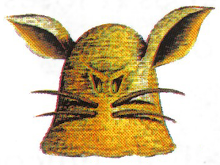 These bunny enemies from the first Zelda title seem pretty unremarkable aside from their odd backstory of being easily defeated with the microphone that was never seen in the US, which was the source of the instruction manual’s claim of them hating noise. However, there’s another point in the instruction manual that makes them pretty disturbing:
These bunny enemies from the first Zelda title seem pretty unremarkable aside from their odd backstory of being easily defeated with the microphone that was never seen in the US, which was the source of the instruction manual’s claim of them hating noise. However, there’s another point in the instruction manual that makes them pretty disturbing:
They are ghosts.
So… what? Are they the ghosts of bunnies? It makes more sense if you look at their artwork or their appearance in Phantom Hourglass, in which they have disturbing, mean faces that at least look like they might be based on a person’s face… but still it raises the question of who or what is this the ghost of?
Also, in Phantom Hourglass their undersides have horrific lamprey mouths, and there’s a metalcore song dedicated to them. Yep.
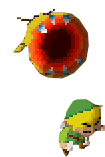
8. Facade (Link’s Awakening, Oracle of Seasons)
 Facade is the boss of the Face Shrine (haha), which also places him in the part of Link’s Awakening where the player discovers the grim truth about Koholint Island. That certainly contributes to his eeriness, but it’s not really why I’m putting him on the list.
Facade is the boss of the Face Shrine (haha), which also places him in the part of Link’s Awakening where the player discovers the grim truth about Koholint Island. That certainly contributes to his eeriness, but it’s not really why I’m putting him on the list.
When it comes down to it… Facade is a really disturbing beast who doesn’t appear so at first. In particular… he is a living room.
During the fight, Facade’s… face… is the weak point, but his body appears to be the entire room: During the fight, he sends pots and floor tiles flying at Link, even opening up holes in the floor, as the room itself attempts to kill the hero. His face periodically emerges from the floor and must be attacked.
Try to picture it outside of the simple 2D graphics: Try to imagine yourself in a room, where holes will suddenly open up without reason, and sometimes a face shows up to mock you and your impending doom. The room is going to kill you. It’s an evil room. Facade kind of makes sense as a living nightmare in Link’s Awakening, but his reappearance in Oracle of Seasons just invites a lot of questions.
7. Great Bay Temple (Majora’s Mask)
 I’ll admit right off the bat that I have a claustrophobic fear of dark or enclosed underwater locations, so both the Lakebed Temple earlier on this list and the Great Bay Temple are special cases for me, but I think it’s worth including a second water-themed dungeon because, again, there’s some really creepy stuff here upon analysis.
I’ll admit right off the bat that I have a claustrophobic fear of dark or enclosed underwater locations, so both the Lakebed Temple earlier on this list and the Great Bay Temple are special cases for me, but I think it’s worth including a second water-themed dungeon because, again, there’s some really creepy stuff here upon analysis.
Namely, the Great Bay temple’s purpose is potentially extremely enigmatic and disturbing. This “temple” is visibly an industrial facility. Not only is it the most technologically advanced area in any Zelda game, but it is all dark metal and pipes. It’s eerie enough on its own with its techno music and dark metallic chambers, but then you think about why this place might exist and what purpose it serves, and it gets so much worse.
Think about it: The Great Bay suffers under what can only be described as an environmental calamity. The seas are heating up and becoming murky, making it impossible to navigate out to the temple without help. But what would cause the water to become unnaturally hot and filthy?
You have two options:
Number one: Great Bay Temple is an actual, honest-to-god industrial facility, and the Skull Kid’s shenanigans have made something go wrong, causing it to contaminate the sea itself with pollutants. Number two: The Great Bay Temple somehow regulates the state of the freaking ocean, which only begs the question of how, and who made it? At best, it’s a hideous chemical factory spewing poison into the ocean, and at worst it’s an unexplained god-machine that controls an entire part of the natural order and yet appears to be entirely man-made. If it’s the latter, then that takes Zelda straight to the far end of cosmic horror. I’m tellin’ you, Gyorg didn’t even know what he was messing with.
6. Bilocyte (Skyward Sword)
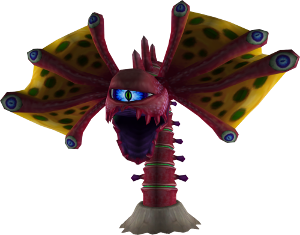 So what’s the worst, most horrific thing you can imagine happening to you? Death? Torture? Pshhh! How about being mind-controlled by a parasite that infests you to the point of overflowing from your body?
So what’s the worst, most horrific thing you can imagine happening to you? Death? Torture? Pshhh! How about being mind-controlled by a parasite that infests you to the point of overflowing from your body?
Right, I’m sorry about that imagery. Well, actually, no, I’m not. It’s not even my imagery; that’s from Skyward Sword!
Late in the game, Link must journey to the Thunderhead and gain the help of the Sky Spirit Levias, but unfortunately Levias isn’t himself. He seems to be a little bit pissed off and also there are eyeball tentacles coming out of his barnacles. I wonder if that’s related?
After destroying all the tentacles and landing on the spirit, Bilocyte the “Ocular Parasite” emerges from Levias’ blowhole. Bilocyte’s a demon, so he clearly defies the natural order heftily enough to make it work, but still I can’t even imagine what kind of parasite needs to be this size. Does Bilocyte purely infest entities as big as Levias? Or does he just grow within the host?
A better question would be… How did Nintendo get away with having a parasitic monster that literally overflows its host, with hideous fleshy extrusions coming out of its every orifice?

5. Shadow Beasts (Twilight Princess)
I’ve talked about this one a bit before. The Shadow Beasts are plenty scary, so maybe I’m cheating by including them (especially this far into the list), but there’s so much subtle horror with them I had to bring them up again.
Of course, the Shadow Beasts are not just mere monsters summoned by Zant to do his bidding, but cursed and warped denizens of both the Twilight and the Light, who are transformed into these creatures by other Shadow Beasts. This is no secret; it’s revealed before even the second dungeon of the game. But how much do we really think about it while playing?
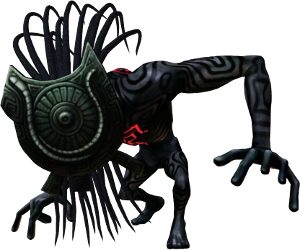 I’ve likened it to a Junji Ito manga — his stories very often telling grisly, disturbing tales of corruption and both mind and body horror — and really it’s such a perfect comparison. It also should be noted how many of these beasts Link has to kill throughout his journey… even after learning about their true nature. At the end of the game he gains a light-empowerment for his sword, allowing him to purify some non-hostile Shadow Beasts, but even after that he must fight and kill a horde of the normal sort before confronting Zant. Why is unclear — perhaps the ones he purifies did not complete the transformation — but either way, this is the only Zelda game where Link is forced to kill so many innocent people, or where so many innocent people are subjected to a fate this horrible. In all probability, death was a release by that point.
I’ve likened it to a Junji Ito manga — his stories very often telling grisly, disturbing tales of corruption and both mind and body horror — and really it’s such a perfect comparison. It also should be noted how many of these beasts Link has to kill throughout his journey… even after learning about their true nature. At the end of the game he gains a light-empowerment for his sword, allowing him to purify some non-hostile Shadow Beasts, but even after that he must fight and kill a horde of the normal sort before confronting Zant. Why is unclear — perhaps the ones he purifies did not complete the transformation — but either way, this is the only Zelda game where Link is forced to kill so many innocent people, or where so many innocent people are subjected to a fate this horrible. In all probability, death was a release by that point.
4. Everything from the Tingle Sub-series
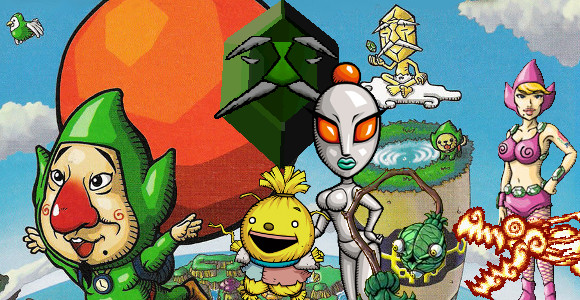
Tingle’s creepy enough as a man-child fairy-nerd in Majora’s Mask or an imprisoned slave-driver in The Wind Waker, but the fact that he has his own sub-series where he is the rupee-craving inhuman servant of a demon, or spends an entire game trying to woo women, kind of just says all you need to know. I don’t feel like I need to elaborate further.
3. Cukeman (most 2D games)
 The precursors of the Chuchus, called Buzz Blobs, are common enemies in A Link to the Past and many of the later 2D Zelda games. These electrified blobs are impossible to kill without stunning them first or using ranged weapons, but are mostly passive. They’re pretty unremarkable, really.
The precursors of the Chuchus, called Buzz Blobs, are common enemies in A Link to the Past and many of the later 2D Zelda games. These electrified blobs are impossible to kill without stunning them first or using ranged weapons, but are mostly passive. They’re pretty unremarkable, really.
Until you sprinkle weird stuff on them, and then they get insane.
Upon using Magic Powder or Mystery Seeds on a Buzz Blob, they transform into the weird huge-eyed Cukemen. These “foes” look strange but otherwise behave pretty much the same, with the exception of the fact that you can now talk to them. Mostly these kinda nerdy-looking blobs just give weird game advice.
Worse however is the weird lines that Claude M. Moyse put into the German version of Link’s Awakening when translating it. There’s really no way I can censor these while still talking about them so… um… brace yourself for these rather sexual phrases:
“Do you have any sorrows, hardships or problems?”
“Give me your juice, I’ll give you mine…”
“Never without a condom!”
…So they blatantly offer sex to you. That’s fine. No, really, that’s not completely inappropriate and screwed up at all. Moyse is known for doing crap like this and it’s really just a very immature translation gag, but like with the Stone of Agony, trying to think about it purely in-world is… twisted beyond belief.

2. Symmetry Village/City (Oracle of Ages)
Found atop Talus Peaks, Symmetry City (or Symmetry Village in the past) is a seemingly pleasant village with a funny little gimmick: Perfect symmetry. Except it’s not just a gimmick; it’s a law. The Tuni Nut, symbol of the village, broke in the past, causing a natural disaster of all things. The volcano can only be calmed by repairing the nut and restoring symmetry.
If the settlement relies so much on symmetry, then to what lengths might they go?
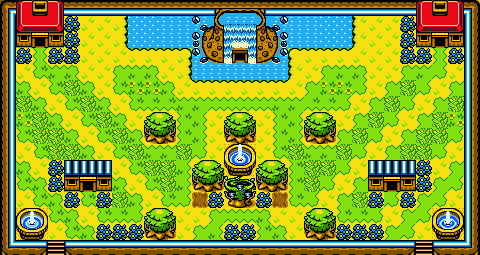
It contains a man who refuses to work out without two dumbbells; the necessity of symmetry here doesn’t end with the village or landscape… it extends to the people itself. While the “forces of symmetry” seem to forgive the village for two people on opposite ends who are not completely identical, you have to wonder how bigger breaches of “balance” are dealt with.
What happens if someone wants to leave their house? Does their counterpart have to leave too? What happens when someone dies? Just think about it a bit, about how twisted this pursuit of perfect symmetry might become. Or take it further: What force is it that demands, desires, needs this symmetry? Is this a cult, or is it something bigger? And why is only this one settlement affected?
If course, Symmetry City is also the location of the Skull Dungeon, one of the three dungeons in Oracle of Ages themed after something spooky… so there’s some food for thought.
1. Most New Elements in Majora’s Mask

Let’s face it, Majora’s Mask is basically Nightmare Fuel: The Game. There’s a lot of outright frightening stuff when it comes to Majora and the Ikana region, but there’s tons of stuff that isn’t outright scary, either, but carries an edge or disturbing implications. And there’s so much of it that, if I’d tried to separate them, this list would be taken over by the game entirely. So let’s just give it the credit it deserves: Virtually every item, character, and creature that first appeared in Majora’s Mask gets the number one spot.
From the hideous mask transformations, to the enigmatic Song of Healing used to solidify pain, sorrow, and evil, there are plenty of objects and upgrades that have twisted implications. The Happy Mask Salesman has a mysterious nature that makes us ask a lot of questions, while Pamela’s Father is beset by horrible happenings and gives rise to one of the game’s freakiest moments. Still others are just strange or disturbing to look at, like the Goron Elder, Kamaro, or Gabora.
Then there’s the sheer amount of freaky-looking enemies. The Dexihand is a hideous, grasping, leprous claw. The Eeno are strange snow-men. The Nejiron is an inexplicably explosive warped image of a Goron. Real Bombchus are freaky grinning rats that explode. Black Boe are swarms of glowing eyes in the dark. And those are just some examples.
Majora’s Mask is a freaky, freaky game, and even when it’s not trying to scare you it really freaking scares you.
Some honorable mentions I hated cutting from the list are Barinade, the Lost Woods and how it turns people into Stalfos, the Oocca, the ghostly Moas from Adventure of Link, and the whip-wielding Snappers from Spirit Tracks. Definitely nightmare fuel in my book, but sadly none of them could compete with the other entries on the list. How about you? What things in Zelda freaked you out that probably weren’t supposed to? ReDeads don’t count! Tell me in the comments, and tell me what you think of my entries too!



